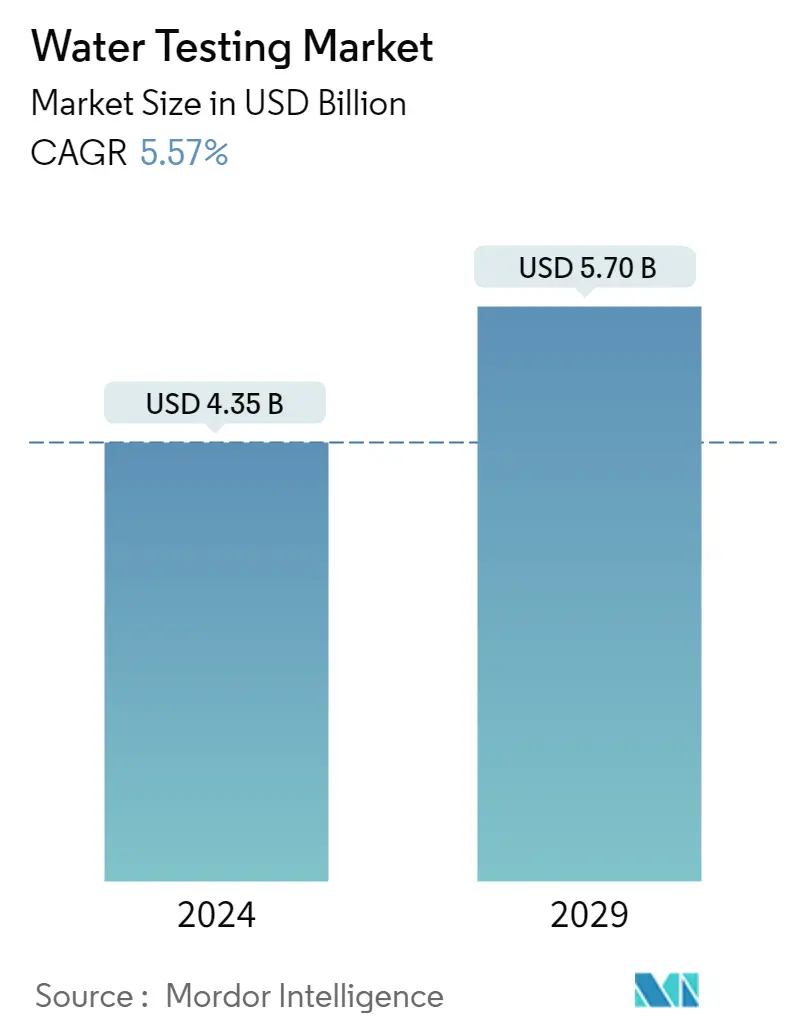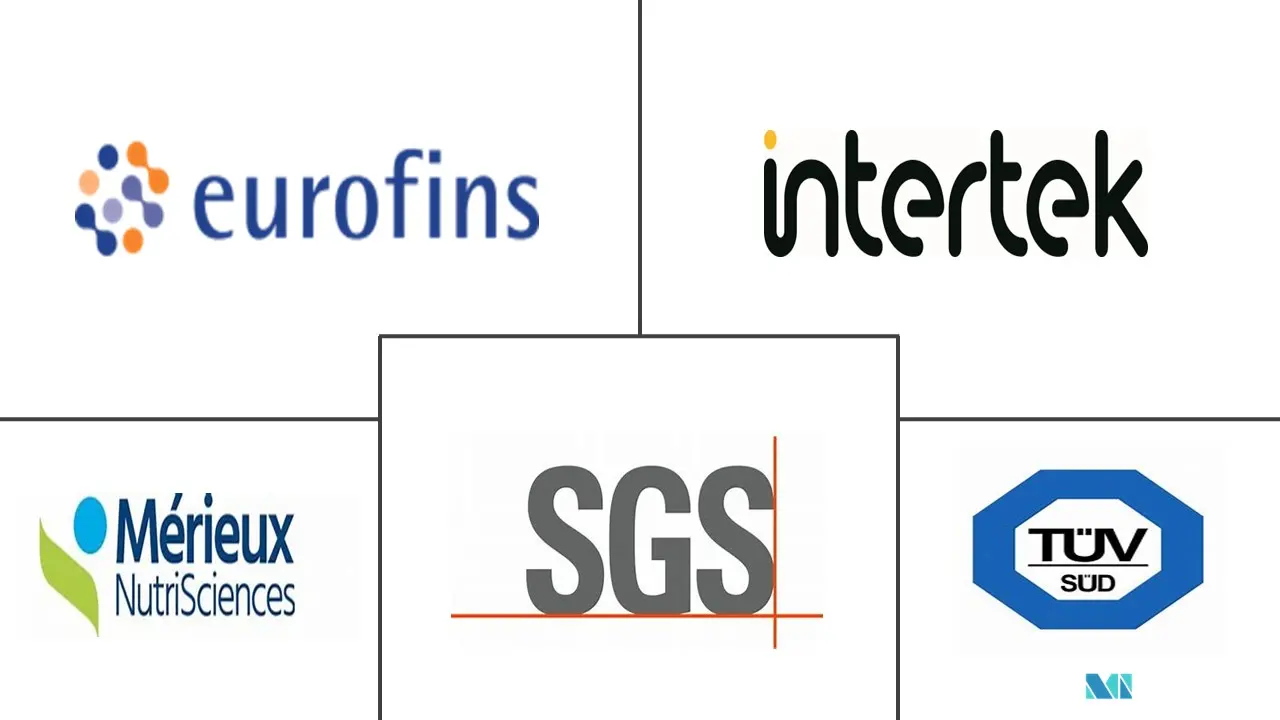Market Size of Water Testing Industry

| Study Period | 2019 - 2029 |
| Market Size (2024) | USD 4.35 Billion |
| Market Size (2029) | USD 5.70 Billion |
| CAGR (2024 - 2029) | 5.57 % |
| Fastest Growing Market | Asia-Pacific |
| Largest Market | North America |
Major Players
*Disclaimer: Major Players sorted in no particular order |
Water Testing Market Analysis
The Water Testing Market size is estimated at USD 4.35 billion in 2024, and is expected to reach USD 5.70 billion by 2029, growing at a CAGR of 5.57% during the forecast period (2024-2029).
- The COVID-19 pandemic had a significant impact on the global water testing market as it affected consumers' lifestyles and increased their chances of spreading coronavirus. Thus, the water and supply chain industries were impacted as consumers became more concerned regarding the security and safety of water-based products. Additionally, in the wake of the pandemic, government bodies, agencies, and Non-Government Organizations have also been contributing significantly to the rising demand for safety across the country.
- For instance, during the time of this pandemic, the United States Food and Drug Administration (FDA) and Federal Trade Commission (FTC) have been closely watching for misleading product claims around COVID-19 prevention or treatment, and even a general 'immunity' claim on a product can be considered an implied claim about COVID-19.
- Over the long term, in developing countries like India, consumable water is expected to be safe and of high nutritional value due to increasing consumer awareness. The rise in consumption of bacteria- and chemical-free water is driving the demand for water testing equipment across the globe.
- Additionally, rising incidences of water-borne diseases, such as typhoid, dysentery, and cholera, are playing a major role in market growth. According to the World Health Organization (WHO), in 2022, approximately 8,29,000 people per year die from diarrheal disease as a result of poor hand hygiene, sanitation, and drinking water. However, diarrhea is largely preventable, and if these risk factors are addressed, infant deaths under the age of five per year may be averted, which is expected to be one of the key drivers for the market over the forecast period.
- Furthermore, the increasing regulatory support and legislation for high standard maintenance of food and beverage products, pharmaceuticals, and other industries, are further increasing the applications of chemically te/sted water. For instance, with the passage of the Food Safety Modernization Act and the Safe Food for Canadians Act, the food safety laws of the United States and Canada have undergone significant modifications recently. Governments have a vested interest in making sure that their food items are safe to eat and adhere to food safety rules.
Water Testing Industry Segmentation
Water testing is carried out to meet regulatory requirements and adhere to the safety procedures required for pollutant-free water. This is a broad concept that involves several procedures to analyze and evaluate the quality of water.
The water testing market is segmented by test type, technology, and geography. Based on test type, the market is segmented into physical tests, chemical tests, and microbiological tests. The chemical test is further sub-segmented into pesticides and heavy metals, and others. By technology, the market is segmented into HPLC-based, LC-MS/MS-based, immunoassay-based, and other technologies. By geography, the market is segmented into North America, Europe, Asia-Pacific, South America, Middle-East and Africa.
For each segment, the market sizing and forecasts have been done on the basis of value (in USD million).
| Test Type | ||||
| Physical Test | ||||
| ||||
| Microbiological Test |
| Technology | |
| HPLC-based | |
| LC-MS/MS-based | |
| Immunoassay-based | |
| Other Technologies |
| Geography | |||||||||
| |||||||||
| |||||||||
| |||||||||
| |||||||||
|
Water Testing Market Size Summary
The water testing market is poised for significant growth, driven by increasing consumer awareness and regulatory demands for safe and clean water. The market has been influenced by the COVID-19 pandemic, which heightened concerns about water safety and prompted regulatory bodies to enforce stricter standards. This has led to a surge in demand for water testing equipment, particularly in developing countries where the safety of consumable water is a growing concern. The rise in waterborne diseases and the need for bacteria- and chemical-free water are key factors propelling the market forward. Additionally, the implementation of stringent regulations in industries such as food and beverage, pharmaceuticals, and others has further expanded the applications of water testing.
Technological advancements and enhanced detection methods have also contributed to the market's expansion, especially in developed economies. The focus on rapid microbiological tests and the development of innovative testing solutions, such as enzyme-substrate medium-based kits, underscore the industry's commitment to ensuring water safety. Key players in the market, including SGS SA, Eurofins Scientific, and Intertek Group PLC, are expanding their facilities and product offerings to meet the growing demand. The competitive landscape is characterized by a focus on service diversification, geographical expansion, and technological innovation, all aimed at maintaining a leading edge in the water testing market.
Water Testing Market Size - Table of Contents
-
1. MARKET DYNAMICS
-
1.1 Market Drivers
-
1.2 Market Restraints
-
1.3 Porter's Five Forces Analysis
-
1.3.1 Threat of New Entrants
-
1.3.2 Bargaining Power of Buyers/Consumers
-
1.3.3 Bargaining Power of Suppliers
-
1.3.4 Threat of Substitute Products
-
1.3.5 Intensity of Competitive Rivalry
-
-
-
2. MARKET SEGMENTATION
-
2.1 Test Type
-
2.1.1 Physical Test
-
2.1.2 Chemical Test
-
2.1.2.1 Pesticides
-
2.1.2.2 Heavy Metals and Others
-
-
2.1.3 Microbiological Test
-
-
2.2 Technology
-
2.2.1 HPLC-based
-
2.2.2 LC-MS/MS-based
-
2.2.3 Immunoassay-based
-
2.2.4 Other Technologies
-
-
2.3 Geography
-
2.3.1 North America
-
2.3.1.1 United States
-
2.3.1.2 Canada
-
2.3.1.3 Mexico
-
2.3.1.4 Rest of North America
-
-
2.3.2 Europe
-
2.3.2.1 United Kingdom
-
2.3.2.2 Germany
-
2.3.2.3 Spain
-
2.3.2.4 France
-
2.3.2.5 Italy
-
2.3.2.6 Russia
-
2.3.2.7 Rest of Europe
-
-
2.3.3 Asia-Pacific
-
2.3.3.1 China
-
2.3.3.2 Japan
-
2.3.3.3 India
-
2.3.3.4 Australia
-
2.3.3.5 Rest of Asia-Pacific
-
-
2.3.4 South America
-
2.3.4.1 Brazil
-
2.3.4.2 Argentina
-
2.3.4.3 Rest of South America
-
-
2.3.5 Middle-East and Africa
-
2.3.5.1 South Africa
-
2.3.5.2 Saudi Arabia
-
2.3.5.3 Rest of Middle-East and Africa
-
-
-
Water Testing Market Size FAQs
How big is the Water Testing Market?
The Water Testing Market size is expected to reach USD 4.35 billion in 2024 and grow at a CAGR of 5.57% to reach USD 5.70 billion by 2029.
What is the current Water Testing Market size?
In 2024, the Water Testing Market size is expected to reach USD 4.35 billion.

